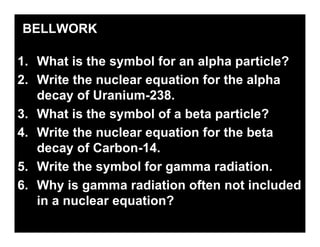
Lecture 25.2- Nuclear Transformations
- 1. BELLWORK 1. What is the symbol for an alpha particle? 2. Write the nuclear equation for the alpha decay of Uranium-238. 3. What is the symbol of a beta particle? 4. Write the nuclear equation for the beta decay of Carbon-14. 5. Write the symbol for gamma radiation. 6. Why is gamma radiation often not included in a nuclear equation?
- 2. 25.2 Lecture 25.2- Nuclear Transformations Radon-222 is a radioactive isotope that is present naturally in the soil in some areas. It has a constant rate of decay. You will learn about decay rates of radioactive substances.
- 3. The nucleus is held together by the strong nuclear force The strong nuclear force is the strongest force known Protons and neutrons are very close together They exchange a teeny bit of mass back and forth. When disrupted, the mass is converted to energy according to E=mc2 The mass is tiny. The energy is immense.
- 4. Protons and neutrons experience the strong nuclear force if close enough Because protons repel each other the nucleus needs a certain proton to neutron ratio for stability
- 5. 25.2 More than 1,500 different nuclei are known. Of those, only 264 are stable and do not decay or change with time. These nuclei are in a region called the band of stability.
- 6. 25.2 Nuclear Stability and Decay The neutron-to- proton ratio determines the type of decay that occurs.
- 7. 25.2 A half-life (t1/2) is the time required for one-half of the nuclei of a radioisotope sample to decay to products. After each half-life, half of the existing radioactive atoms have decayed into atoms of a new element.
- 8. 25.2
- 9. 25.2
- 10. 25.2 Stable Isotope
- 11. 25.2 The ratio of Carbon-14 to stable carbon in the remains of an organism changes in a predictable way that enables the archaeologist to obtain an estimate of its age.
- 12. 25.1
- 13. 25.1
- 14. 25.1
- 15. 25.1
- 16. for Sample Problem 25.1
- 17. 25.2 The conversion of an atom of one element to an atom of another element is called transmutation. Transmutation can occur by radioactive decay. Or when particles bombard the nucleus of an atom.
- 18. 25.2 The first artificial transmutation reaction involved bombarding nitrogen gas with alpha particles.
- 19. 25.2 The elements in the periodic table with atomic numbers above 92, the atomic number of uranium, are called the transuranium elements. • All transuranium elements undergo transmutation. • None of the transuranium elements occur in nature, and all of them are radioactive.
- 20. 25.2 Transuranium elements are synthesized in nuclear reactors and nuclear accelerators.
- 21. 25.2 Section Quiz. 1. During nuclear decay, if the atomic number decreases by one but the mass number is unchanged, the radiation emitted is a. a positron. b. an alpha particle. c. a neutron. d. a proton.
- 22. 25.2 Section Quiz. 2. When potassium-40 (atomic number 19) decays into calcium-40 (atomic number 20), the process can be described as a. positron emission. b. alpha emission. c. beta emission. d. electron capture.
- 23. 25.2 Section Quiz. 3. If there were 128 grams of radioactive material initially, what mass remains after four half-lives? a. 4 grams b. 32 grams c. 16 grams d. 8 grams
- 24. 25.2 Section Quiz. 4. When transmutation occurs, the ________ always changes. a. number of electrons b. mass number c. atomic number d. number of neutrons
- 25. 25.2 Section Quiz 5. Transmutation occurs by radioactive decay and also by a. extreme heating. b. chemical reaction. c. high intensity electrical discharge. d. particle bombardment of the nucleus.